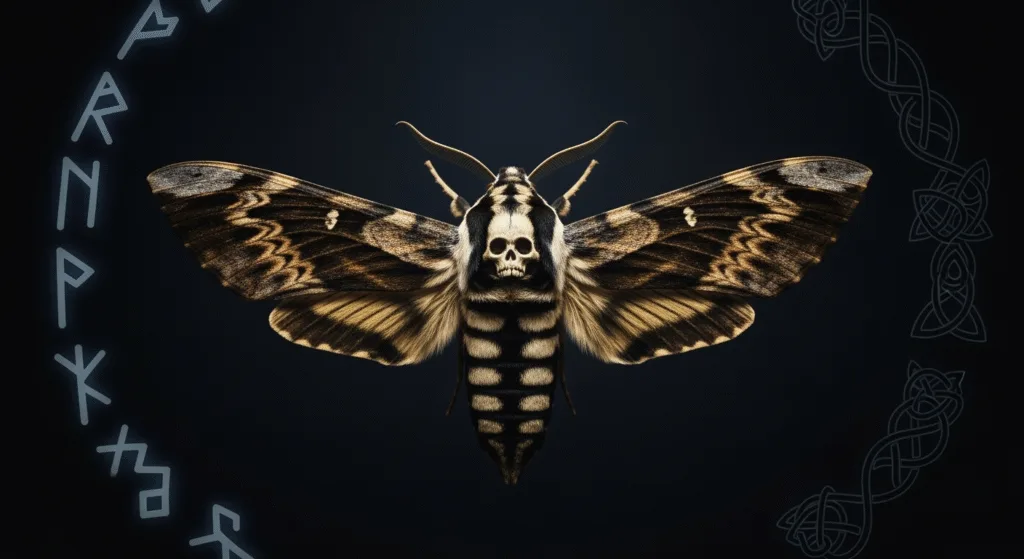A Moth Shrouded in Mystery
The death head hawk moth is one of the most fascinating insects in the natural world. Known for the eerie skull-like marking on its thorax, this moth has intrigued scientists, artists, and storytellers for centuries. While many moths blend silently into nature, this particular species stands out for its remarkable pattern and its legendary reputation. In this article, we will explore everything you need to know about the death head hawk moth—its biology, behavior, cultural significance, and the myths that surround it.
Physical Appearance and Identification

The death head hawk moth earns its name from the distinctive skull-shaped pattern on its thorax. This striking design sets it apart from most moths, which usually display camouflage for protection. Its wingspan ranges from 90 to 130 millimeters, making it a large and noticeable insect. The forewings are typically mottled brown and gray, while the hindwings feature strong yellow and black bands.
Unique Characteristics
- Skull-like thorax marking
- Yellow and black hindwings
- Strong, rapid wing beats
- Ability to squeak when threatened
Another curious trait of this insect is its unusual ability to produce a squeaking sound. Unlike most moths that remain silent, the death head hawk moth squeals when touched or disturbed. Scientists believe this trait helps scare off potential predators.
Habitat and Distribution
These moths belong to the genus Acherontia, which includes a few species distributed across parts of Europe, Africa, and Asia. The most widely recognized is the Acherontia atropos, common in Africa and Europe. The Acherontia styx and Acherontia lachesis are found in Asia, particularly in India and Southeast Asia.
Typical Habitats
The death head hawk moth thrives in warm regions with agriculture. It often lives near fields of potatoes, tomatoes, or other nightshade plants because these serve as food for its caterpillars. Adults prefer gardens, forests, or fields where flowers provide nectar.
| Region | Species | Habitat Preference |
|---|---|---|
| Europe & Africa | Acherontia atropos | Fields and woodlands |
| South Asia | Acherontia styx | Tropical gardens and farmland |
| Southeast Asia | Acherontia lachesis | Dense forests and rural fields |
Behavior and Feeding Habits
The death head hawk moth displays unique behaviors that make it unlike most other moths. Most notably, it is famous for invading beehives. Instead of avoiding bees, it sneaks into hives to steal honey. Due to its thick body covering and chemical disguise, it often escapes undetected. Scientists suggest that its waxy cuticle prevents bee stings from being fatal, and it can mimic the bees’ odor to reduce aggression from the colony.
Diet and Feeding
The moth’s diet changes through its life cycle:
- Caterpillar: Feeds on nightshade plants such as potatoes, tomatoes, and eggplants.
- Adult Moth: Enjoys nectar but shows a remarkable preference for honey.
Interestingly, adult moths use their strong proboscis to pierce wax and extract nectar or honey. This behavior distinguishes them from most moth species, which typically feed only on flower nectar.
Cultural Symbolism and Mythology

No insect carries such a dark reputation as the death head hawk moth. Its striking appearance and squeaking sound have fueled superstitions for hundreds of years. In many cultures, spotting one of these moths was seen as an omen of death or misfortune.
Folklore and Myths
- European folklore: Associated with bad luck and doom whenever it appeared indoors.
- African traditions: Sometimes believed to carry the spirits of ancestors.
- Modern symbolism: Featured in films, books, and art, often linked to mystery and horror.
One of the most well-known appearances of this moth in popular culture is its symbolism in horror and thriller genres. Its haunting look makes it a natural fit for stories that explore dark or mysterious themes.
Life Cycle and Reproduction
The death head hawk moth goes through a complete metamorphosis like all moths and butterflies. Its transformation includes four major stages: egg, larva (caterpillar), pupa (chrysalis), and adult.
Stages of Development
- Egg: Females lay tiny greenish eggs on host plants.
- Caterpillar: Caterpillars grow large—up to 120 mm—and may be green, yellow, or brown, with distinctive diagonal stripes.
- Pupa: Caterpillars bury themselves in soil and pupate underground.
- Adult: Emerges with its iconic skull motif and powerful wings.
Caterpillars can be surprisingly colorful compared to the adult moth. Predators often avoid them due to their size and habit of thrashing when disturbed.
Conservation and Human Impact
Unlike many insects currently under threat, the death head hawk moth has a relatively stable population. However, agricultural pesticide use and habitat destruction have reduced its numbers in some regions. Farmers often see its caterpillar stage as a pest because it feeds on important crops like potatoes and tomatoes.
Threats to Survival
- Pesticide and chemical use in agriculture
- Loss of habitats such as forests and wild gardens
- Climate changes affecting plant growth cycles
Conservation Efforts
Conservation often focuses more broadly on protecting pollinators. By safeguarding natural habitats and reducing pesticide use, people can help preserve not only this moth but many beneficial insect species.
Conclusion: A Creature of Wonder
The death head hawk moth continues to fascinate people worldwide. With its eerie skull marking, honey-stealing habits, and mysterious reputation, it reminds us that nature holds countless surprises. While some fear its ghostly appearance, others see it as a symbol of transformation and resilience. By learning more about such creatures, we gain a deeper appreciation for the role they play in ecosystems and for the myths they inspire in human culture.



